Psychology 301 Exam (3)
0.0(0)
Card Sorting
1/93
Earn XP
Description and Tags
Study Analytics
Name | Mastery | Learn | Test | Matching | Spaced |
|---|
No study sessions yet.
94 Terms
1
New cards
Pupil
A muscle in which light passes through. It is located in front of the lens. The size of it is controlled by the iris.
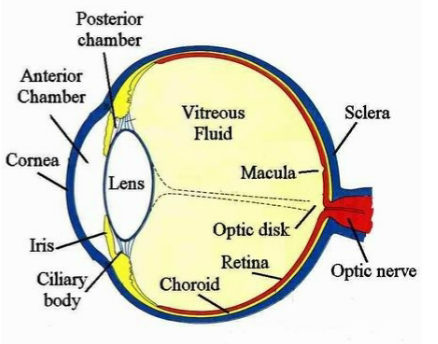
2
New cards
Lens
Transparent, biconvex in the anterior portion of the eye (being the Iris) that provides for adjustable focus the optical system.
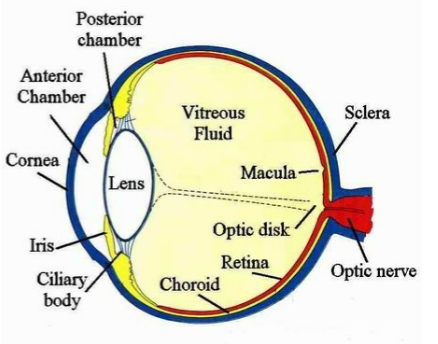
3
New cards
Ciliary Muscles
Changes the shape of the lens when in focus on a near object (accommodation). Controls the relaxation (weak focus)/contraction (strong focus; narrow) of the focusing power of the lens.
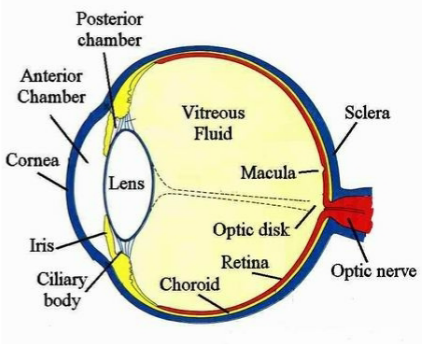
4
New cards
Retina
Contains rods and cones. Layer of neurons in the back of the eye which is responsible for providing sensory signals to convey a visual picture. Attached to photoreceptors.
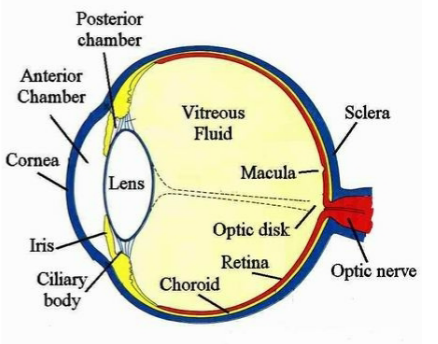
5
New cards
Contralateral Processing of Visual Field
Each side of the brain processes visual information from here. Visual stimulus is processed on the opposite side of which it was detected.
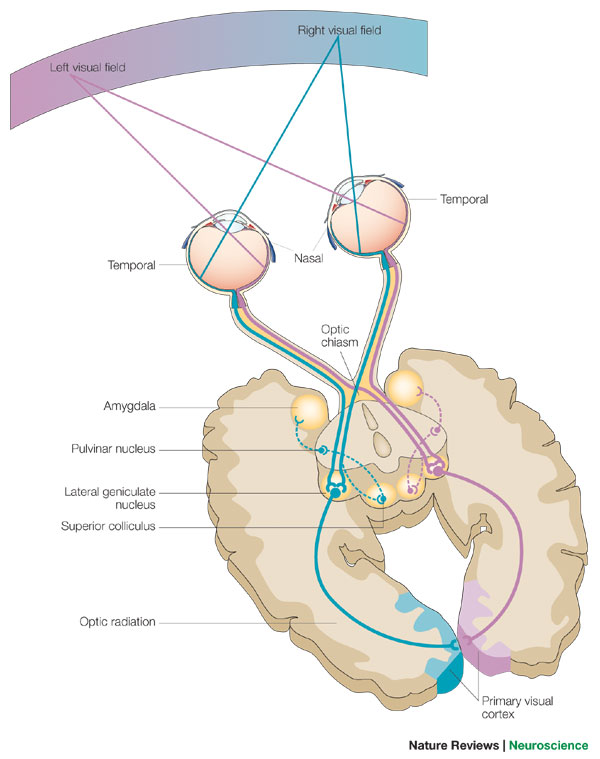
6
New cards
Primary Visual Cortex
Region of the brain which receives, integrates, and processes visual information from the Retinas. Features "On/Off" Cells that include an Excitatory Receptive Field, a Bar of Light, and an Inhibitory Receptive Field which detects orientation, size, and the visual field.
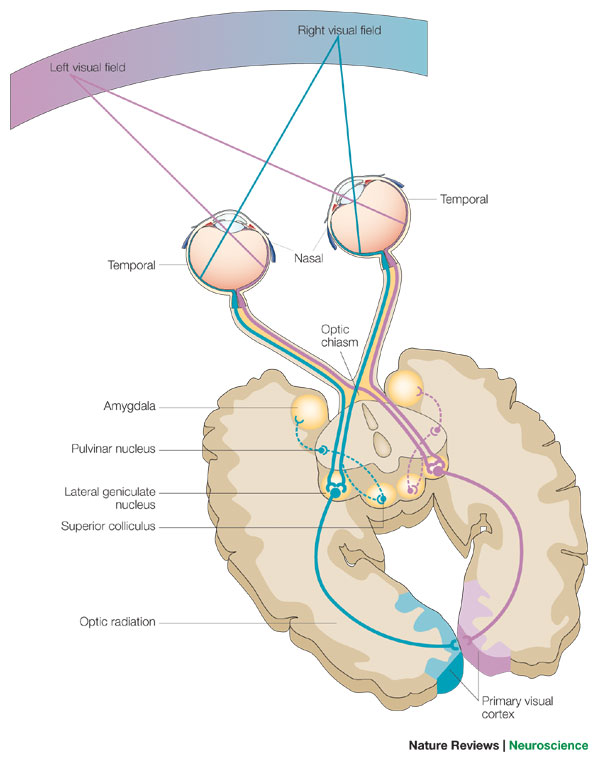
7
New cards
Pattern Recognition
Matches information from a stimulus with information retrieved from memory. The existence of meaningful relationships between stimuli.
(Top Row) Words, Objects, and Faces
(From Objects stem the recognition of): Living/Animate as well as Non-Living/Inanimate
(Top Row) Words, Objects, and Faces
(From Objects stem the recognition of): Living/Animate as well as Non-Living/Inanimate
8
New cards
Template Matching
pattern recognition continues by comparing incoming sensory stimulation to mental images/representations of patterns (templates) until a match is found.
Relatively inflexible system; Holistic match to stored representation.
ex: seeing an animal that looks like a dog and comparing all of its features to what you're aware a dog looks like until you're able to mentally confirm that the animal is indeed a dog.
Relatively inflexible system; Holistic match to stored representation.
ex: seeing an animal that looks like a dog and comparing all of its features to what you're aware a dog looks like until you're able to mentally confirm that the animal is indeed a dog.
9
New cards
Feature Analysis
The notion is that we perceive different features of each object we see and use those features with increasing complexity to identify and categorize objects.
Our visual stimulus is broken into component lines. Similar patterns of those lines are used to distinguish distinctive features. If information is presented too rapidly, it is easy to misinterpret. (e.g., P vs R)
Our visual stimulus is broken into component lines. Similar patterns of those lines are used to distinguish distinctive features. If information is presented too rapidly, it is easy to misinterpret. (e.g., P vs R)
10
New cards
Feature Detectors
Individual/Group cells that respond to:
Orientation (Line, Angles, Movements, etc.)
Part of the Visual Field
Size
What's Next? They pass these onto supercell clusters which respond to more complex patterns.
Orientation (Line, Angles, Movements, etc.)
Part of the Visual Field
Size
What's Next? They pass these onto supercell clusters which respond to more complex patterns.
11
New cards
Receptive Field (on/off center cells)
Subdivision of the Ganglion Cells and interacts with Bipolar Cells. ON cells receive input from ON bipolar cells while OFF cells receive input from OFF bipolar cells.
ON cells respond to stimulus with a burst of Action Potential. OFF cells respond to stimulus with sustained discharge. (light = stimulus)
ON cells respond to stimulus with a burst of Action Potential. OFF cells respond to stimulus with sustained discharge. (light = stimulus)
12
New cards
Simple cells
(V1 neurons) Response in receptive field is opposite to that of the flanking field. Perceives stimuli with particular orientation to objects within their receptive field (edges/gratings)
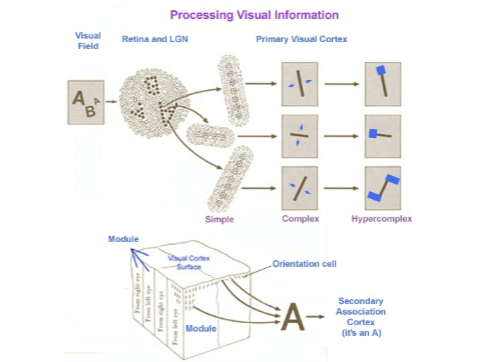
13
New cards
Complex Cells
Sensitive to Line Orientation and Movement in a given direction. 3:1 ratio of simple cells to _____ cells
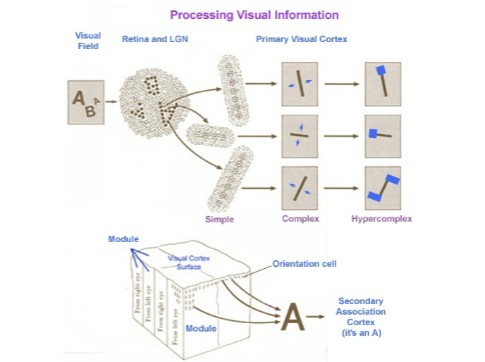
14
New cards
Hypercomplex Cells
Contains an inhibitory region at each end which allows it to maximally respond to lines of a given orientation if they are not too long.
End-Stopping: Decrease in fire to increasingly larger stimuli
End-Stopping: Decrease in fire to increasingly larger stimuli
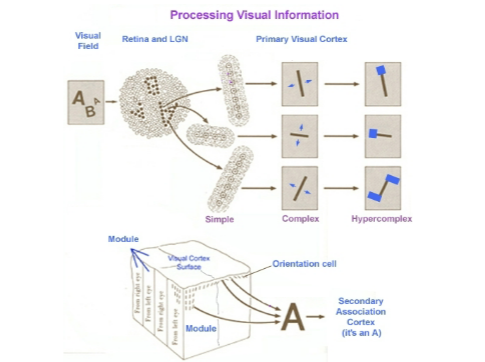
15
New cards
What/Where or Perception/Action Systems
"Where": Dorsal (Occipitoparietal) Pathway
"What": Ventral (Occipitotemporal) Pathway
Named by: Ungerleider and Mishkin
"What": Ventral (Occipitotemporal) Pathway
Named by: Ungerleider and Mishkin
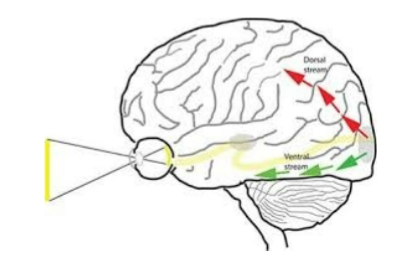
16
New cards
Occipitoparietal/Dorsal System
Spatial Perception (Ungerleider and Mishkin)
Evolved for visually guided reaching and grasping; Vision for action (Goodale and Milner)
Evolved for visually guided reaching and grasping; Vision for action (Goodale and Milner)
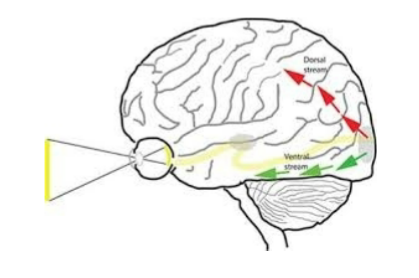
17
New cards
Occipitotemporal/Ventral System
Object Recognition
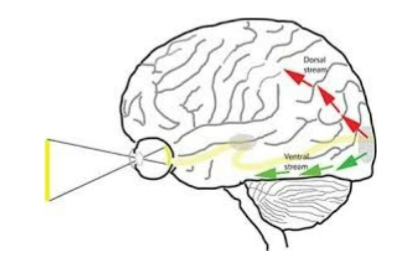
18
New cards
Brain Areas V1-V5
V1: Primary Visual Cortex (outputs to all levels)
V2: Relays visual signals to all areas (input from LGN and output to all levels)
--> Output to Parietal Lobe (Dorsal), Inferior Temporal Lobe (Ventral), and Superior Temporal Sulcus (STS)
V3: Form and Motion (3a)
V4: Form and Color: Activated by non-scrambled objects
V5: Motion
V2: Relays visual signals to all areas (input from LGN and output to all levels)
--> Output to Parietal Lobe (Dorsal), Inferior Temporal Lobe (Ventral), and Superior Temporal Sulcus (STS)
V3: Form and Motion (3a)
V4: Form and Color: Activated by non-scrambled objects
V5: Motion
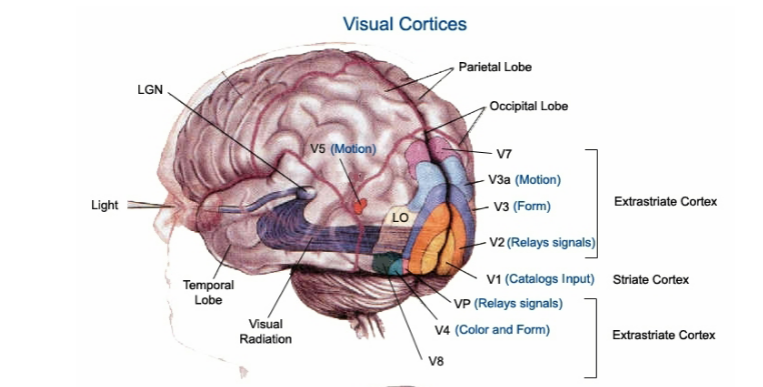
19
New cards
Top-down Processing
The interpretation of incoming information based on prior knowledge, experience, and expectations.
20
New cards
Word Superiority Effect
(Reicher)
Word
Anagram
Letter --> Identified more accurately in words than alone
Followed by a mask
Word
Anagram
Letter --> Identified more accurately in words than alone
Followed by a mask
21
New cards
Context effects in recognition
Error connection through syntactic contextual rules, Taxonomic categories such as numbers/letters, and syntactic rules of the language you speak.
22
New cards
Proofreader's Error
visual error in how a word is spelled, owing to the theory of top-down processing in which the context/cues of a word rather than how it is presented is outweighted.
23
New cards
Phonemic Restoration Effect
AUDITORY
ex: "the _eel was on the axle" vs "the _eel was on the shoe"
ex: "the _eel was on the axle" vs "the _eel was on the shoe"
24
New cards
Connectionist Models
(Selfridge)
The weight of features can be changed over time, depending on their experience.
Model: Image demons are scanned by Feature demons who signal loudly or softly if their feature is found. Letter demons then signal loudly or softly depending on their degree of match via input from the Feature demons.
The weight of features can be changed over time, depending on their experience.
Model: Image demons are scanned by Feature demons who signal loudly or softly if their feature is found. Letter demons then signal loudly or softly depending on their degree of match via input from the Feature demons.
25
New cards
Spreading Activation
Excitatory connections from one level to adjacent levels
(McCelland and Rumelhart)
(McCelland and Rumelhart)
26
New cards
Bigrams
Detectors that add explanatory power. They detect ordered pairs for words [ex: 'CART' has the ordered pairs of CA, RT, CR, CT, AR, AT, RC, RT, RA] (Grainger and Whitney)
27
New cards
Repetition/Semantic Priming
Explained by Spreading Activation; ______ priming refers to the observation that a response to a target (e.g.,DOG) is faster when preceding a semantically related prime (e.g., CAT) rather than something unrelated (e.g., BUS) while _____ priming refers to the change in responding to a word/object due to previous encounters with that same item.
28
New cards
Nodes
At levels of features, letters, words. Followed by Bigrams. Have different thresholds of activation depending on the level of frequency.
29
New cards
Thresholds of activation
Point in which a stimulus will incur a response within an organism. Nodes are dependent on this and frequency levels.
30
New cards
Excitatory/Inhibitory Connections
____ connections prompt one neuron to share information with the next via action potential while _____ connections reduce this from happening; ____connections of Nodes are at the same level.
31
New cards
Neisser's Search For Z
Findings: Recall Time longer for letter matrix with similar features as a result of memory interference.
32
New cards
Inferior Temporal Lobe
Damage to this area makes match to correct shape difficult
33
New cards
Posterior Parietal Region
Damage to this area makes locational choices difficult
34
New cards
Goodale and Milner
Patient with bilateral damage to her lateral occipital complex. Unable to perceive form, size, or orientation objects, but was able to grasp them.
Results: Visual control of grasping not dependent on form processing.
Results: Visual control of grasping not dependent on form processing.
35
New cards
How is Top-Down Processing instituted in Connectionist Models?
Feedback loops to Lower levels;
They both connect via TD Processing using outside knowledge to form neural networks to create connections with different letters that allows us to automatically process words with missing letters.
(ex: dog with a b_og) (ex: cof_e a_d t_a)
They both connect via TD Processing using outside knowledge to form neural networks to create connections with different letters that allows us to automatically process words with missing letters.
(ex: dog with a b_og) (ex: cof_e a_d t_a)
36
New cards
Object Recognition-by-Components
Marr's Modular Approach to Visual Perception
1. Image Intensity/Primal Sketch
1a. Binocular Stereo 1b. Motion 1c. Shape from Shading 1d. Texture 1f. Color
2. 2 1/2 Sketch (must match to 3D)
1. Image Intensity/Primal Sketch
1a. Binocular Stereo 1b. Motion 1c. Shape from Shading 1d. Texture 1f. Color
2. 2 1/2 Sketch (must match to 3D)
37
New cards
Geons
Geometric Ions
Component parts of objects
Component parts of objects
38
New cards
Vertex/Vertices
2 geons are combined
39
New cards
Fusiform Gyrus
Part of the brain that processes "brain-like" stimuli
Located in the Inferior Medial Temporal Lobe
Configuration seems to be most important for this stimuli to properly function
Located in the Inferior Medial Temporal Lobe
Configuration seems to be most important for this stimuli to properly function
40
New cards
Visual Agnosia
A "without" + "gnosia" knowledge
Contains Agnosia, Prosopagnosia, and Alexia (Inability to recognize words)
Contains Agnosia, Prosopagnosia, and Alexia (Inability to recognize words)
41
New cards
Form Agnosia
May maintain
1. Acuity
2. Color
3. Motion
Impaired
1. Shape Recognition
2. Matching Stimuli
2. Integrating Stimuli
1. Acuity
2. Color
3. Motion
Impaired
1. Shape Recognition
2. Matching Stimuli
2. Integrating Stimuli
42
New cards
Integrative Agnosia (HJA)
Left or Bilateral Occipital-Temporal Damage
1. Difficulty recognizing objects visually
2. Can define/recognize objects if presented in verbal, auditory, haptic domains
3. Visual perception accurate enough to copy and object
1. Difficulty recognizing objects visually
2. Can define/recognize objects if presented in verbal, auditory, haptic domains
3. Visual perception accurate enough to copy and object
43
New cards
Transformational Agnosia
Inability to manipulate/rotate percept to match to Viewer Independent stored representation of objects
44
New cards
Prosopagnosia
Inability to recognize faces
45
New cards
Attention
The concentration of awareness on some phenomenon to the exclusion of other stimuli
46
New cards
Dichotic Listening Tasks
2 messages pipelined to separate ears. Subject can either pay attention to 1 message
47
New cards
Selective Attention
Paying attention to one message, and ignore other
Unattended/Attended messages
Unattended/Attended messages
48
New cards
Divided Attention
Monitor two messages or tasks simultaneously (connection to cell phones while driving and accidents)
49
New cards
Capacity Models of Attention
Available resources used per demands of various tasks. Not bottleneck; need to allocate attentional resources and performance fails if tasks outweighs resources. Performance declines when need exceeds capacity.
50
New cards
Illusory Conjunctions
When overloaded, people confuse mixture of traits (e.g., people reporting seeing a blue car when they actually saw a red car)
51
New cards
Spotlight Analogy
Attention is focused on a single location and everything within its beam is attended and processed preferentially, while information outside of the beam is unattended to.
52
New cards
Hemispatial (or unilateral) neglect
Patients with unilateral brain damage to the Right inferior parietal love and/or temporal/parietal junction often ignore the opposite side of space.
More common on the Right hemisphere.
Visual Field is contralateral to lesion is ignored; Ipsilateral visual field is attended to
More common on the Right hemisphere.
Visual Field is contralateral to lesion is ignored; Ipsilateral visual field is attended to
53
New cards
Biased Competition Theory
Right Visual Field "wins" and patients have difficulty disengaging from that winning visual field to process information from their Left Visual Field.(John Duncan)
Exhibit "Sticky Attention": prolonged attention on an object (e.g, Barbell Study; Tipper/Behr)
Exhibit "Sticky Attention": prolonged attention on an object (e.g, Barbell Study; Tipper/Behr)
54
New cards
Temporal/Parietal Junction
Also known as the Superior Temporal Sulcus. Important for cognitive empathy and perspective-taking. Damage to this area causes Wernicke's Aphasia.
55
New cards
Dorsal Simultagnosia
Typically due to bilateral damage to the Temporo-Parietal Junction.
Patients "recognize" only one object out of an array.
Patients "recognize" only one object out of an array.
56
New cards
Parietal Lobe
Vital for sensory perception and integration, including management of the 5 senses. Interprets input from other parts of the body. Allows us to coordinate our movements in response to the objects in our environment through the use of visual pathways.
57
New cards
2 1/2 D Sketch
How surfaces relate to each other in structure as well as physical characteristics, distance, location, and orientation.
Viewer dependent and still based on input from retinal processing while combining lower-level "modules"
Viewer dependent and still based on input from retinal processing while combining lower-level "modules"
58
New cards
3D Object Centered Description
Viewer-Independent representation -- Stored in memory as canonical view
59
New cards
HJA
Can identify: Letters, Visuals/Auditory (simple), Logic (Definitions/Reasonings), Parts of face
Impaired: Whole faces, whole words, whole complex object, and color
Impaired: Whole faces, whole words, whole complex object, and color
60
New cards
Integration Hypothesis
Inability to combine local parts into a global whole (Humphreys and Riddoch)
61
New cards
Shadowing
Dichotic listening task where subject is asked to repeat aloud one or both message/s.
62
New cards
Neisser and Becklen (Attention)
found divided attention led to 8x more errors as selective attention in a visual task.
63
New cards
Prefrontal Cortex
Part of the brain responsible for Selective/Divided attention, Inhibition of non-intended stimuli, and the Use of Deliberate Cognitive Strategies such as memory
64
New cards
Automatic v Effortful Processing
Controlled Processing
1. Innate (Spatial processing, Frequency processing, and Temporal Processing [time/order])
2. Learned (an effortful process that becomes automatic, such as word recognition)
Hasher and Zacks
1. Innate (Spatial processing, Frequency processing, and Temporal Processing [time/order])
2. Learned (an effortful process that becomes automatic, such as word recognition)
Hasher and Zacks
65
New cards
Stroop Task
The automatic skill of reading interferes with naming ink color in the interference condition
ex: reading the word "Purple" with red text.
ex: reading the word "Purple" with red text.
66
New cards
Spatial, frequency, temporal processing
1. to tell where an object is
2. to tell how many times an object appears in a given space
3. to tell the order or time in which an object appears in a given space
2. to tell how many times an object appears in a given space
3. to tell the order or time in which an object appears in a given space
67
New cards
Incidental vs. intentional learning
Unplanned learning that results from doing activities vs Planned learning that results from doing activities
68
New cards
Task interference
Automatic processes interfere with effortful processes, or with other automatic processes.
69
New cards
Change Blindness
Failure to detect objects that appear or disappear in an array
Found in Hemispatial neglect patients and Barbell stimulus (Behrmann and Tipper)
Found in Hemispatial neglect patients and Barbell stimulus (Behrmann and Tipper)
70
New cards
Inattentional blindness
Failing to perceive a stimulus in plain sight
71
New cards
Representational failure
Inattentional Blindness
Never being able to have a full representation of a visual scene. Makes it difficult to compare something if an object to be compared was not spotted in the original scene.
Never being able to have a full representation of a visual scene. Makes it difficult to compare something if an object to be compared was not spotted in the original scene.
72
New cards
Comparison failure
Initial representation stored but with an inability to compare two representations (initial vs changed scene)
73
New cards
Mental imagery
mental representations of an image associated with memory. does not require a direct external stimulus.
74
New cards
What is Treisman and Gelade associated with?
Spotlight Analogy
75
New cards
Name the findings of Treisman and Gelade
1. Attention and Integration (perceiving an object and its characteristics only through its shape)
2.Pop out effect
3.Significant function of Attention being to bind features into coherent object representations
4.Spotlight analogy
2.Pop out effect
3.Significant function of Attention being to bind features into coherent object representations
4.Spotlight analogy
76
New cards
What is Hemispatial Neglect NOT
Sensory/Visual problem (Shows semantic priming based on neglected visual field)
77
New cards
Flicker Techinque
Visual scene presented for 100-500msec, ISI=interstimulus interval, changed visual scene
78
New cards
What was Change Blindness first applied to?
Grimes; People miss large changes during saccadic eye movements
79
New cards
Why does Change Blindness occur?
Prevents visual and cognitive overload
80
New cards
What is Automatic Processing not affected by?
Individual differences in cognition
81
New cards
Quasi-picture view of Imagery
Visual information represented depictionally (like a photo)
Maintains visual and spatial properties of original stimulus (ISOMORPHIC)
Imaging = Seeing
Maintains visual and spatial properties of original stimulus (ISOMORPHIC)
Imaging = Seeing
82
New cards
Analogical representation
Captures some of the characteristics of what they represent (e.g., maps, pictures, and diagrams)
83
New cards
Functional Equivalence
Perceptual overlap between emotion expressions and certain trait markers, which then influences emotional communication.
84
New cards
Implicit encoding
Spatial relations can be implicitly represented in a picture/image without explicit attention ever being paid to the spatial relations.
85
New cards
Perceptual equivalence
Imaging is like seeing (mind's eye); the same 'visual screen' is used
86
New cards
Transformational equivalence
Images can be scanned, rotated, etc. in the same way as actual pictures or spatial stimuli
87
New cards
Structural equivalence
The structure of Images is like that of actual perceived objects
88
New cards
Image generation
Takes longer to construct more detailed images or those described as having more parts, e.g., "two overlapping rectangles" vs. "five squares in form of a cross"
89
New cards
Mental rotation
The ability to imagine how an object that has been seen from one perspective would look if it were rotated in space into a new orientation and viewed from the new perspective
90
New cards
Neurological equivalence
B/T imaging processing and seeing.
Higher activity in occipital lobe and posterior cortex during imagery tasks (including dreaming)
Higher activity in occipital lobe and posterior cortex during imagery tasks (including dreaming)
91
New cards
Intramodal interference
Image and Perception share a visual buffer
92
New cards
Conceptual-Propositional Theory
In long term memory, we store concepts rather than sensory data.
1. Inclusion/Exclusion
2. Actions
3. Attributes
4. Spatial Position
1. Inclusion/Exclusion
2. Actions
3. Attributes
4. Spatial Position
93
New cards
Indeterminacy
Mental images leave out significant details, and cannot be re-analyzed for those details the way that pictures can.
ex: image of tiger does not specify an exact number of stripes
ex: image of tiger does not specify an exact number of stripes
94
New cards
Name a fact regarding Neurological Equivalence
Same area of Auditory Association Area active when listening to music and mentally filling in gaps in music